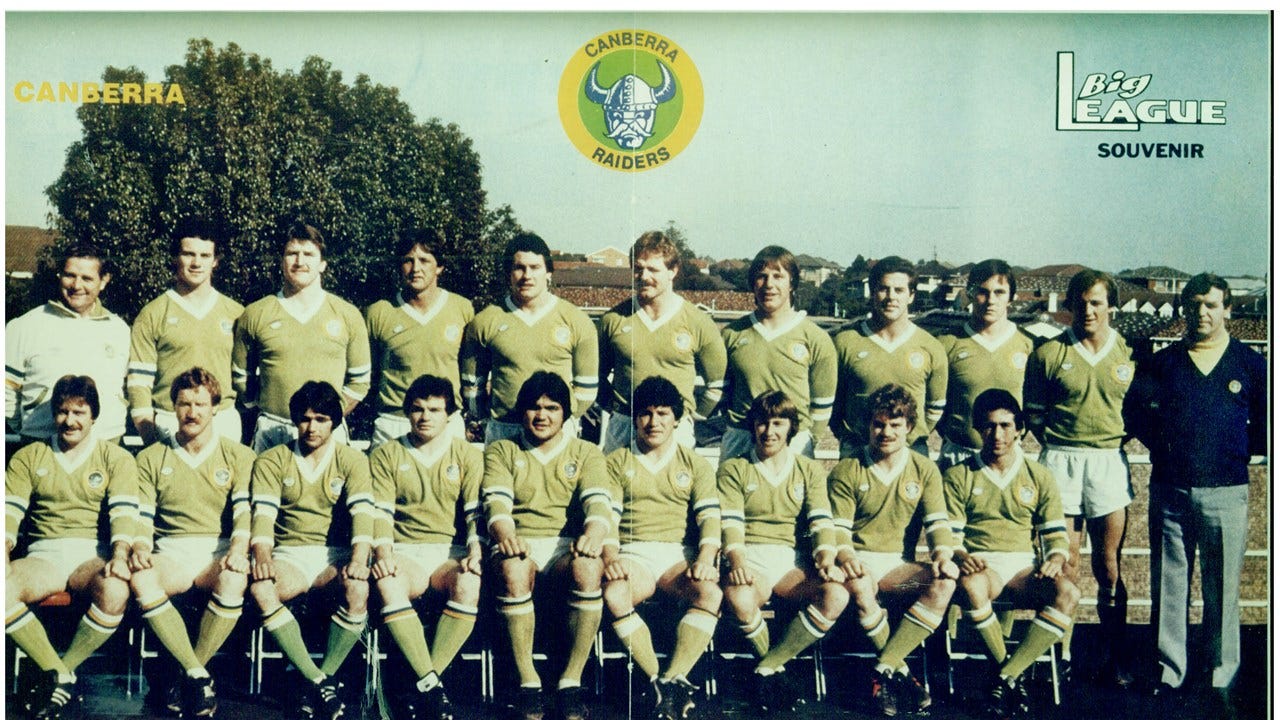From Gerry de la Cruz to Danie Gerber: How Don Furner made the Raiders
The colours came from a phantom, the green from a couch at Queanbeyan Leagues and the name from a business trip to San Francisco. And the players came from the eagle eye of Don Furner.
No Big Match preview today, sports fans, (we’ll win, it’s all good) because flat out like so many if not all the lizards drinking so! Follows is a free extract from The Milk, the book, which has sold out in hard copy format but which, going forward, you may purchase for $1 a week, $5 a month or $50 a year and receive daily extracts like the following, plus the normal weekly preview, plus selected rugby league merch like T-shirts, hoodies, beanies, and suchforth.
In other news, check out the Daily Telegraph and other News Ltd journals for the Tigers-Raiders match report.
*
EVERYONE TALKED to Don Furner.
Mate, should see this bloke up at Murwillumbah! Gun player!
Mate! Should see this bloke from Cooma! What a goer!
And Furner would nod along and stroke his metaphorical goat-beard, aware that most of these hot tips would come to nothing. Though he would go and see for himself.
One day he went out to Junee after several of his old mates1 had worded him up about this 16-year-old kid, Laurie Daley.
Mate! Kicked a field goal to win a grand final in A-Grade! And Donny? He can go.
Furner was in Brisbane in 1981 when a truck driver assured him there was a bloke in Darwin who could really play.
“Darwin?” scoffed Furner, 48. “I could play in Darwin.”
Nevertheless, up north he went a-hunting. And he came back with the signature of Gerry De La Cruz, who would score the club’s first ever try, break his arm after four games and never play again. Furner later said De La Cruz could’ve been anything.
Furner already was.
Born on Boxing Day in 1931 he became a Queensland state champion heavyweight boxer who contested the Australian title in 1953. When he was knocked out he gave it away because his mum asked him to. Furner listened to his mum.
He and his brother grew up tough, and poor, around the Balmain docks because his dad was a drinker who deserted the family to work as a rigger on the recently opened Sydney Harbour Bridge. Furner never touched a drop, or smoked, or even swore.
But he was very good at rugby league, touring with the Kangaroos in 1957 as a second-rower and playing his one Test at Oldham when Norm Provan was injured.
He came back, took to the bush and to coaching, winning premierships with Junee and Tumbarumba. He came to Queanbeyan to coach the Blues and won 10 premierships in 13 seasons. He was so good that the Roosters of Sydney asked that he bring his eye for talent up to the Smoke.
Wayne Bennett once said Furner was among the top three talent spotters he’d known. At Eastern Suburbs Furner recruited Arthur Beetson, Ron Coote, John Brass, John Ballesty and Mark Harris.The club made the ’72 grand final (won 19-14 by Manly).
To Canberra he brought Terry Fahey, Ron Giteau, Mal Meninga2, Gary Belcher, Peter Jackson, Sam Backo, Kevin Walters, Steve Walters and Gary Coyne.

Furner brought hundreds of players to the Raiders, including dozens of fresh wannabe footballers who turned up at the new club’s first training session at Seiffert Oval, Monday, November 1st, 1981.
And there, on the same day a show at Yarralumla Woolshed begat a Canberra Times headline “97 goats presented” and 11-year-old Bradley Clyde of Holt Primary School won the 800m final at the ACT Primary Schools Sports Association track and field championship, upwards of 80 footballers, man and boy, listened to Furner speak.
Peter McGrath was one of them. He’d been playing under Furner at Queanbeyan United for five years. He felt like he knew everyone bar the new blokes from Sydney and Queensland.
“Canberra wasn’t that big a footy community. You knew the good players. I’d played rugby with Sammy Vucago since I was 18. The bigger deal was getting to know the guys that came from outside.
“Moulding a culture, be it workplace or football club, is difficult. And it was difficult to start. All those different people, cultures, views. We had no history. No standards. We looked to Donny and the coaches. And they were a disparate group themselves,” McGrath says.

Into the trials and Furner “encouraged the team to play”, according to McGrath. “He could’ve picked a defensive team and lost by less. But he never did. He picked guys who’d play footy. And that carried on. That was culture building right there. I mean we lost – by lots – and it was tough.
“But our four wins in that first year were good, entertaining games. We were proud of how we played. We were proud of the footy club. It set the place up for the future. Even now – it’s in the DNA.
“It’s how we play.”
Next: Chapter Two - Game One, Game On.
Don Furner was captain-coach of Junee Diesels in 1964.
According to John McIntyre in a piece by Jon Tuxworth in The Canberra Times, the club’s target before Meninga had been South African rugby star Danie Gerber, a powerful, goal-kicking centre in the Meninga mould. The deal fell through, the Raiders signed Meninga from Brisbane Souths and Gerber played 24 Tests for the Springboks. ‘‘We were very close to signing [Gerber],” McIntyre said. “Unfortunately the dollars we could provide him were nowhere near what he was getting in South Africa. In the end, he was probably the inspiration for targeting Mal Meninga.”





